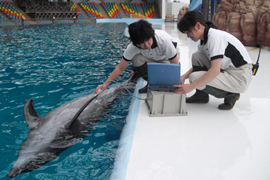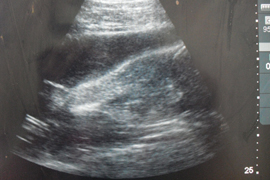Safari&Marine
Safari&Marineイルカの妊娠診断 〜新しい命の誕生に向けて〜
2011年09月10日(土)

マリンライブで活躍しているバンドウイルカは、毎日パフォーマンスのためのトレーニングを実施しています。また、体の異常を早期に発見出来るように、体温測定や採血などの健康チェックのための訓練も欠かせません。妊娠の可能性のあるイルカは、まず血液中の妊娠に関わるホルモンの値を検査します。ホルモン値が持続して高くなれば妊娠と判定します。ヒトの妊娠はお腹の中の赤ちゃんを確認するために、超音波(エコー)検査を行っていますが、実は人間と同様にイルカにもエコー検査を実施しています。
イルカをプールで仰向けにして、エコーの機械(プローブ)をお腹にあて、体内の様子を観察します。もちろん人間のように簡単にはいきません。初めてエコーを体験するイルカは、機械を警戒してなかなかうまくいきません。何回か検査を繰返すことで痛くないと学習し、じっくり観察出来るようになります。バンドウイルカの妊娠期間は約1年間。1回の出産で1頭の赤ちゃんを産みます。エコー検査で胎児の大きさを測ることで、出産時期も予測出来ます。出産時期が近づくと、安全に出産するために母親を出産用のプールに移動させます。

また、ヒトでは出産直前に体温が低下しますが、イルカも同様な変化を示します。イルカやクジラは出産の24時間前になると、体温が約1℃下がります。出産予定日が近づくと、毎朝ドキドキしながら体温測定を行います。
このようにエコー検査や体温測定を行い、母親イルカが無事出産出来るようにサポートします。
(尾崎 美樹)

